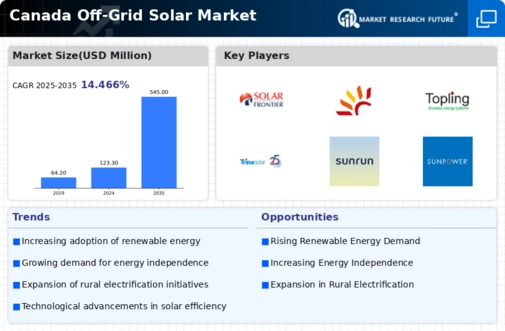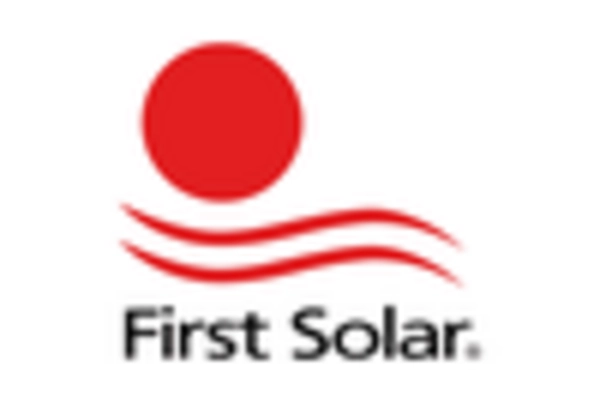The off grid-solar market in Canada is characterized by a dynamic competitive landscape, driven by increasing demand for renewable energy solutions and a growing emphasis on sustainability. Key players such as Canadian Solar Inc (CA), Sunnova Energy International Inc (US), and First Solar Inc (US) are actively shaping the market through strategic initiatives. Canadian Solar Inc (CA) focuses on innovation in solar technology, emphasizing high-efficiency modules and energy storage solutions, which positions it favorably in a market that increasingly values performance and reliability. Meanwhile, Sunnova Energy International Inc (US) is expanding its footprint through partnerships with local installers, enhancing its service offerings and customer reach. First Solar Inc (US) is concentrating on vertical integration, optimizing its supply chain to reduce costs and improve product availability, thereby enhancing its competitive edge.
The business tactics employed by these companies reflect a trend towards localizing manufacturing and optimizing supply chains to mitigate risks associated with global disruptions. The market structure appears moderately fragmented, with several players vying for market share, yet the influence of major companies is substantial. Their collective strategies not only enhance their individual market positions but also contribute to a more competitive environment, fostering innovation and efficiency across the sector.
In October 2025, Canadian Solar Inc (CA) announced a partnership with a leading energy storage provider to develop integrated solar-plus-storage solutions aimed at off-grid applications. This strategic move is likely to enhance their product offerings, catering to the growing demand for energy independence among consumers in remote areas. The integration of storage capabilities is crucial, as it allows for greater energy reliability and efficiency, aligning with the market's shift towards comprehensive energy solutions.
In September 2025, Sunnova Energy International Inc (US) launched a new financing program designed to make solar installations more accessible for residential customers in rural areas. This initiative not only broadens their customer base but also addresses the financial barriers that often hinder solar adoption in off-grid settings. By facilitating easier access to financing, Sunnova is likely to capture a larger share of the market, particularly among consumers who prioritize affordability and sustainability.
In August 2025, First Solar Inc (US) unveiled a new line of solar panels that utilize advanced materials to enhance efficiency and durability. This innovation is expected to set a new benchmark in the industry, potentially attracting customers who are increasingly discerning about product performance. The introduction of such cutting-edge technology underscores First Solar's commitment to maintaining a leadership position in the market, particularly as competition intensifies.
As of November 2025, current trends in the off grid-solar market indicate a strong focus on digitalization, sustainability, and the integration of artificial intelligence in energy management systems. Strategic alliances among companies are becoming more prevalent, fostering collaboration that enhances technological advancements and market reach. Looking ahead, competitive differentiation is likely to evolve, with a shift from price-based competition to a greater emphasis on innovation, technology, and supply chain reliability. This transition suggests that companies that prioritize these aspects will be better positioned to thrive in an increasingly competitive landscape.

















Leave a Comment